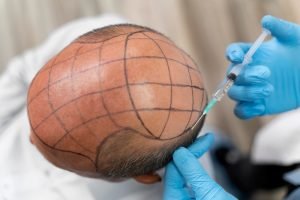When it comes to addressing hair loss and regaining a full head of hair, hair transplantation methods offer hope and tangible results. Two of the most prominent techniques in the world of hair restoration are Follicular Unit Transplantation (FUT) and Follicular Unit Extraction (FUE). Each method has its unique approach, advantages, and considerations, making them suitable for different cases and patient preferences.
Follicular Unit Transplantation (FUT): The Traditional Approach
Follicular Unit Transplantation, often referred to as FUT, represents the traditional and time-tested approach to hair transplantation. The method involves a series of meticulous steps:
1. Harvesting a Strip of Scalp:
The journey begins by identifying and marking the donor area, which is typically located at the back of the head. Here, the hair follicles are genetically resistant to hair loss. A strip of scalp containing these healthy follicles is surgically removed. This strip can vary in size depending on the number of grafts needed.
2. Follicle Dissection:
The harvested strip of scalp is then delicately dissected into individual follicular units under a microscope. These units contain one to four hair follicles each. The precision of this dissection process is crucial to ensuring the survival and vitality of the follicles.
3. Implantation:
With the follicular units prepared, the next step involves creating tiny incisions in the recipient area, where hair restoration is desired. These incisions are carefully made in a natural and aesthetically pleasing pattern. Subsequently, the dissected follicular units are implanted into these recipient sites.
FUT has been known to yield excellent results, often leading to natural-looking hair growth. However, it’s important to note that this method leaves a linear scar at the donor site. While this scar can typically be concealed by surrounding hair, it’s a consideration for those who prefer to wear their hair very short.
Follicular Unit Extraction (FUE): The Minimally Invasive Alternative
In recent years, Follicular Unit Extraction (FUE) has gained popularity as a minimally invasive and scarless alternative to FUT. This method offers an appealing option for individuals seeking a discreet and efficient hair transplantation procedure:
1. Individual Follicle Extraction:
Unlike FUT, which involves the removal of a strip of scalp, FUE focuses on individual follicle extraction. Specialized instruments and small punches are used to delicately harvest hair follicles one by one from the donor area. This approach minimizes the need for surgical incisions.
2. Recipient Site Creation:
After the follicles are extracted, tiny incisions are created in the recipient area, following a natural hairline and distribution pattern. This step is crucial for the subsequent implantation of the harvested follicles.
3. Implantation:
Individual hair follicles, also known as grafts, are carefully transplanted into the recipient sites. The precision of implantation ensures that the transplanted hair grows in a natural and aesthetically pleasing manner.
One of the primary advantages of FUE is its ability to leave only tiny, dot-like scars at the donor site. These scars are significantly less noticeable compared to the linear scar left by FUT. This makes FUE an attractive option for individuals who prefer to wear their hair short or maintain closely cropped hairstyles.
Choosing the Right Method:
The choice between FUT and FUE should be based on various factors, including individual needs, preferences, and the specific characteristics of hair loss:
- FUT may be preferred when a significant number of grafts are required, and the patient is willing to accept the linear scar in exchange for potentially more cost-effective graft harvesting.
- FUE is an excellent choice for those seeking minimal scarring, a quicker recovery, and the flexibility to wear shorter hairstyles. It’s especially suitable for patients with smaller to moderate hair restoration needs.
In Conclusion:
Both Follicular Unit Transplantation (FUT) and Follicular Unit Extraction (FUE) are effective methods for addressing hair loss and achieving natural-looking hair restoration. The choice between the two methods should be based on individual factors and preferences. Consulting with a qualified hair restoration specialist can provide valuable insights and recommendations tailored to your unique situation. Ultimately, the goal of both methods is the same: to help individuals regain their confidence and achieve the hair they desire.





